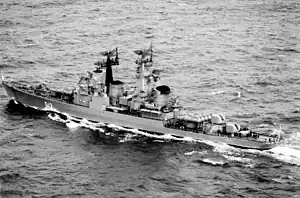Soviet cruiser Varyag (1963)
Varyag (Russian: Варяг) was the fourth and final ship of the Soviet Navy Project 58 Groznyy-class Guided Missile Cruisers (Ракетные крейсера проекта, RKR), also known as the Kynda Class.
 Varyag on 9 September 1989. | |
| History | |
|---|---|
| Name | Varyag |
| Namesake | Varangians |
| Builder | A.A. Zhdanov, Leningrad |
| Yard number | 783 |
| Laid down | 13 October 1961 |
| Launched | 7 April 1963 |
| Commissioned | 20 August 1965 |
| Decommissioned | 19 April 1990 |
| Stricken | April 1990 |
| Fate | Scrapped |
| General characteristics | |
| Class and type | Groznyy class cruiser |
| Displacement | 4,350 tonnes (4,280 long tons; 4,800 short tons) standard, 5,400 tonnes (5,300 long tons; 6,000 short tons) full load |
| Length | 142.7 m (468 ft) |
| Beam | 16 m (52 ft) |
| Draft | 5.01 m (16.4 ft) |
| Propulsion | 2 shaft; 4 x KVN-95/64 boilers, 2 x TV-12 GTZA steam turbines, 45,000 shp (34,000 kW) |
| Speed | 34.5 knots (64 km/h) |
| Range | 4,500 nmi (8,334 km) at 14.3 knots (26 km/h) |
| Complement | 25 officers, 304 men |
| Sensors and processing systems | 2 x MR-300 Angara air/surface search radars, 1 x Bizan, 1 x MRP-11-12, 2 x MRP-13-14 and 2 x MRP-15-16 Zaliv reconnaissance radars, 1 x Don navigation radar, 2 x Nickel-KM and 2 x Khrom-KM IFF, 1 x Vizir-1 and 1 x GS-572 Gerkules-2M sonar |
| Electronic warfare & decoys | 2 x Krab-11, 2 x Krab-12 ESM radar system |
| Armament |
|
| Aircraft carried | Helipad for 1 Kamov Ka-25 'Hormone-A' |
Design
Displacing 4,350 tonnes (4,280 long tons; 4,800 short tons) standard and 5,300 tonnes (5,200 long tons; 5,800 short tons) full load, Varyag was 142.7 m (468 ft) in length.[1] Power was provided by two 45,000 horsepower (34,000 kW) TV-12 steam turbines, fuelled by four KVN-95/64 boilers and driving two fixed pitch screws. Top speed was 34.5 knots (64 km/h).[2]
The ship was designed for anti-ship warfare around two quadruple SM-70 P-35 launchers for 4K44 missiles (NATO reporting name SS-N-3 'Shaddock’), the vessel carrying a full set of reloads making a total of sixteen missiles.[2] To defend against aircraft, the ship was equipped with a single twin ZIF-102 M-1 Volna launcher with sixteen V-600 4K90 (SA-N-1 ‘Goa’) missiles forward and two twin 76 mm (3 in) guns aft, backed up by two single 45 mm (2 in) guns.[2] Four AK-630 close-in weapon systems were added in the early 1980s.[3] Defence against submarines was provided by two triple 533 mm (21 in) torpedoes and a pair of RBU-6000 213 mm (8 in) anti-submarine rocket launchers.[1]
Service
Laid down 13 October 1961 with the name Soobrazitelnyy (Russian: Сообразительный – Astute), the vessel was renamed Varyag on 31 October 1962 while under construction.[4]
Varyag was launched on 7 April 1963 and accepted to the Pacific Fleet on 23 September 1965 as part of the 175th Anti-Submarine Warfare Brigade, sailing to Vladivostok via the northern sea route. The vessel served in the Indian Ocean between 13 December 1971 and 6 March 1972 as part of a substantial Soviet naval presence during the Indo-Pakistani War ostensibly as a counterweight to ensure non-intervention by the Royal Navy and US Navy. Between 1975 and 1981, Varyag underwent repairs and modernisation, returning to service in the Indian Ocean with a cruise that included a visit to Da Nang, Vietnam between 10 and 14 October 1981. The ship was attached to the 183rd Anti-Submarine Warfare Brigade from 1 March 1985, taking part in a large surface fleet exercise with other Soviet vessels between 7 and 10 October 1988.[4]
Varyag was the first in the class to be decommissioned, being stricken in April 1990.
Pennant numbers
| Pennant Number[2] | Date |
|---|---|
| 343 | 1965 |
| 280 | 1965 |
| 621 | 1966 |
| 822 | 1967 |
| 835 | 1968 |
| 830 | 1970 |
| 835 | 1972 |
| 836 | 1974 |
| 015 | 1976 |
| 049 | 1981 |
| 047 | 1982 |
| 043 | 1985 |
| 012 | 1987 |
| 032 | 1990 |
| 641 | |
| 821 | |
| 079 | |
References
- Moore, John (1980). Jane's Fighting Ships 1980-1981. London: Jane's. ISBN 9780710607034.
- Volkov, Roman; Brichevsky, Andrew (2016). "Guided Missile Cruisers: Project 58 Grozny". Russian Ships. Retrieved 14 November 2017.
- Hampshire, Edward (2017). Soviet Cold War Guided Missile Cruisers. Oxford: Osprey Publishing. p. 45. ISBN 9781472817402.
- Holm, Michael (2015). "Project 58 Kynda class". Soviet Armed Forces 1945–1991. Retrieved 14 November 2017.